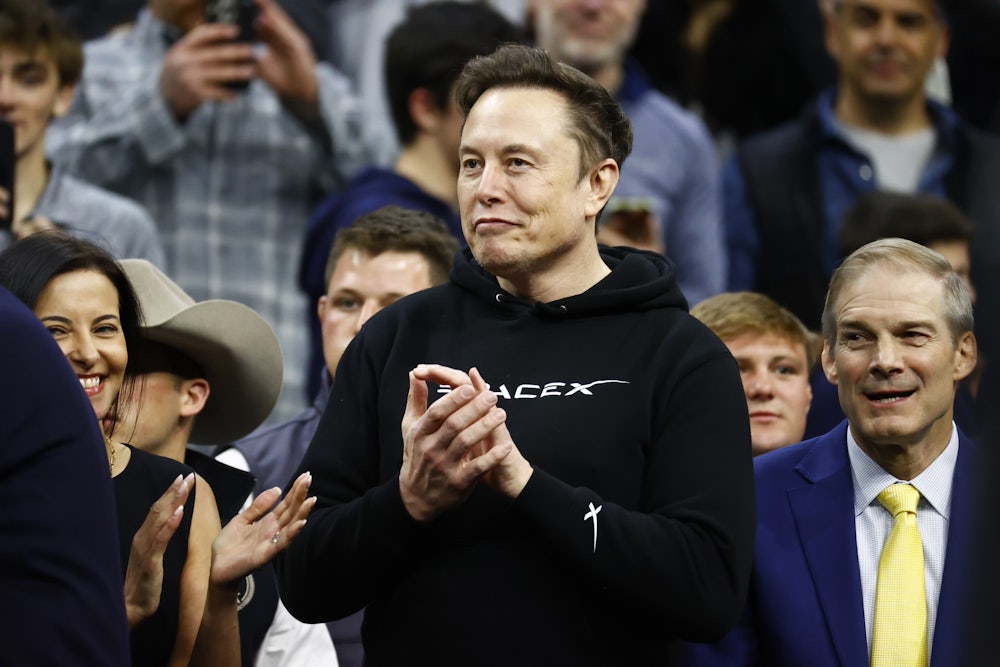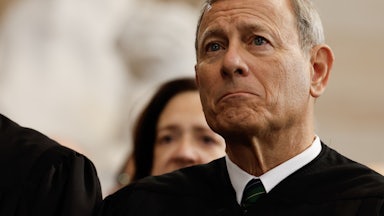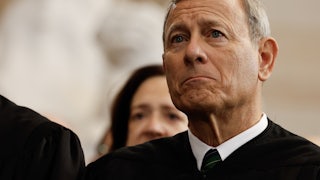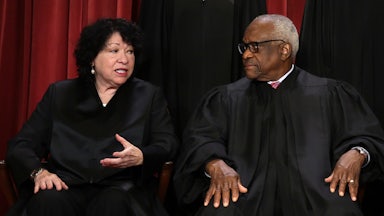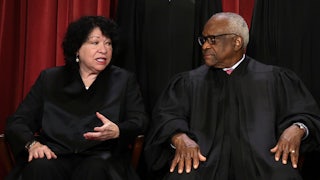The Fifth Circuit Court of Appeals ruled on Tuesday that the National Labor Relations Board’s structure is unconstitutional, dealing another severe blow to the board’s ability to resolve labor-management disputes and enforce federal labor laws across the country.
The case itself reads like a Gilded Age parable. South African–born billionaire Elon Musk, the world’s wealthiest man, had asked the court to block the board’s enforcement actions against one of his companies for its alleged anti-union activities. A panel of three Republican-appointed federal judges in Texas, two of whom were appointed by President Donald Trump, agreed with him.
“The Employers have made their case and should not have to choose between compliance and constitutionality,” Judge Don Willett wrote for the panel, referring to Musk’s company SpaceX and two others that had sued on similar grounds. “When an agency’s structure violates the separation of powers, the harm is immediate—and the remedy must be, too.”
Tuesday’s ruling in SpaceX v. NLRB is a significant blow to American workers who hope to organize their workplaces without fear of retaliation. It represents a partial negation of the New Deal, along with 90 years of legal precedent—and a victory for the conservative legal establishment’s war against federal regulatory power.
At issue in this case is whether the NLRB’s actions were unconstitutional because, under federal law, its five-member board and its administrative-law judges cannot be fired by the president at will. NLRB board members can only be removed “for neglect of duty or malfeasance in office, but for no other cause,” while the ALJs can only be removed “for good cause” after a hearing before a specialized federal civil service board.
The NLRB’s structure is laid out by the National Labor Relations Act of 1935, a New Deal–era law that enshrined a range of new legal protections for organized labor in the private sector. Two months before the NLRA’s passage, the Supreme Court had ruled in Humphrey’s Executor v. United States that Congress could lawfully enact for-cause removal protections for the heads of independent agencies under certain conditions. This legal and constitutional backdrop remained intact for the last 90 years.
Overturning Humphrey’s Executor is a major goal of the conservative legal establishment, which generally seeks to maximize executive power and minimize legislative and regulatory power. Right-wing judges and legal scholars instead emphasized Myers v. United States, a 1926 decision that strengthened the president’s removal power. Instead of reading Humphrey’s Executor to supersede Myers, the Roberts court has argued that Myers represents the general rule and Humphrey’s Executor is a mere exception to it—one that happens to get narrower and narrower each time the court glances at it.
That view was given an official imprimatur by the 2020 case Seila Law v. Consumer Financial Protection Bureau. The court’s conservative majority struck down the for-cause removal provision that prevented Trump from dismissing the CFPB’s director. Chief Justice John Roberts distinguished the CFPB from other independent agencies that fell under Humphrey’s Executor (like the Federal Trade Commission and the Securities and Exchange Commission) by noting that those agencies were headed by multi-member boards instead of a single appointee.
Justice Elena Kagan, writing in dissent, disputed Roberts’s claim that the ruling was compelled by precedent or historical practice, as well as his overzealous approach to the separation of powers. “[The conservative majority] writes in rules to the Constitution that the drafters knew well enough not to put there,” she wrote. “It repudiates the lessons of American experience, from the 18th century to the present day. And it commits the Nation to a static version of governance, incapable of responding to new conditions and challenges.”
The ruling achieved a major right-wing policy goal—defanging and disrupting the CFPB’s functions—while also avoiding more far-reaching consequences to other agencies. The FTC and SEC remained untouched. More importantly, so did the Federal Reserve Board of Governors, which wields enormous power over both U.S. and international financial systems. Many court watchers assume that the justices were unwilling to undermine the Fed’s independence—especially under Trump, a frequent Fed critic—because of the serious economic consequences that could follow.
But while the Fed seemed secure from judicial interference, a host of other agencies soon found themselves under the gun. After Seila Law, the Roberts court took aim at other protections against removal. The court held in Collins v. Yellin, for example, that the director of the Federal Housing Finance Agency must be stripped of his for-cause protections as well. At the same time, the justices also rejected the idea that because it found the FHFA’s structure to be unconstitutional, it must also invalidate the agency’s actions that took place while it was unconstitutionally structured.
“All the officers who headed the FHFA during the time in question were properly appointed,” Justice Samuel Alito wrote for the court. (Emphasis his.) “Although the statute unconstitutionally limited the President’s authority to remove the confirmed Directors, there was no constitutional defect in the statutorily prescribed method of appointment to that office.” As a result, he concluded, the plaintiffs could not argue that the challenged action was automatically invalid.
The companies behind Tuesday’s ruling—SpaceX, Energy Transfer, and Findhelp—all faced investigations and hearings by the NLRB over charges of unfair labor practices. In response, they sued the agency to argue that its structure was unconstitutional because of the for-cause removal protections for its board members and its ALJs. All three companies prevailed at the district court level, prompting the NLRB to appeal to the Fifth Circuit.
Much of the panel’s analysis echoes that of the Supreme Court’s rulings in Seila Law and related cases: The president’s removal power is broad, Congress can only limit it in certain narrow circumstances, and the NLRB does not fall under those exceptions because, among other reasons, it wields “substantial executive power” unlike the agencies at issue in Humphrey’s Executor.
Willett also cited the Supreme Court’s shadow-docket rulings about the NLRB when reaching his decision. Earlier this year, Trump fired NLRB board member Gwynne Wilcox despite the statutory for-cause protections for her removal. She filed a lawsuit and asked the courts to block her dismissal pending further litigation. While the lower courts sided with Wilcox, the Supreme Court sided with Trump.
“The stay reflects our judgment that the Government is likely to show that both the NLRB and MSPB exercise considerable executive power,” the justices wrote in an unsigned opinion, also referring to another agency where a fired board member was suing Trump over their ouster. “But we do not ultimately decide in this posture whether the NLRB or MSPB falls within such a recognized exception; that question is better left for resolution after full briefing and argument.”
Willett, writing for the Fifth Circuit this week, nonetheless took that explanation as justification for his own ruling. “In staying an injunction that barred President Trump from removing [Wilcox], the Court observed that ‘the Government is likely to show that both the NLRB and MSPB exercise considerable executive power,’” the panel wrote. “While the Justices were careful to say that they ‘did not ultimately decide’ the issue, their stay order reinforces our conclusion that Board Members’ insulation from presidential removal likely violates Article II.”
There is little reason to doubt that the Supreme Court will eventually side with Willett on the merits. The court’s conservative majority has made its antipathy toward for-cause removal protections, even for multi-member boards covered by Humphrey’s Executor, clear in Wilcox and in another shadow-docket case in June involving members of the Consumer Product Safety Commission. They even invented a bespoke exemption out of whole cloth for the Federal Reserve in Wilcox to avoid any complications there.
At the same time, Willett also went further than the Supreme Court to effectively neutralize the agency for the time being. In both Seila Law and Collins, the high court held that the for-cause removal protections at issue meant that the respective agencies’ structure was unconstitutional. The justices’ remedy was to “sever” the removal protections from the rest of the statute. In effect, the agency could continue to function as normal, with the director’s removability the only legal change in how it operates.
That is not what the Fifth Circuit did in SpaceX. The NLRB argued that if the court ruled against the for-cause protections for that agency as well, then severability would be the best course. Instead, Willett distinguished the case from Seila Law and Collins by noting that those cases had reached the court on the merits, whereas this one was in a preliminary-injunction stage. As a result, he blocked the agency from operating against the plaintiffs altogether.
“If the Employers later prevail on the merits, we may then consider whether severance is appropriate,” Willett wrote. “At this stage, however, the severability inquiry is premature and belongs to the merits phase, when the court considers final relief.” By allowing the injunctions to stand in full, the court effectively sidestepped Alito’s conclusion in Collins that an agency’s action could only be invalidated if the officer were illegally appointed, and not if they were unconstitutionally insulated from removal.
The Supreme Court may eventually alter that portion of the decision down the road and allow the agency to continue to operate in some form. But the damage is already done. Wilcox’s dismissal left the agency without a quorum to operate with new cases involving unfair labor practices, and the Fifth Circuit’s ruling blocked its ability to work on ongoing ones. Thanks to the Roberts court’s enthusiasm for the unitary executive theory, Trump and Musk have nullified a central pillar of the New Deal and weakened workers’ ability to organize without facing illegal retaliation.
